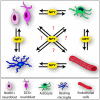Cellular targets for neuropeptide Y-mediated control of adult neurogenesis
- PMID: 25852477
- PMCID: PMC4360818
- DOI: 10.3389/fncel.2015.00085
Cellular targets for neuropeptide Y-mediated control of adult neurogenesis
Abstract
Neuropeptides are emerging as key regulators of stem cell niche activities in health and disease, both inside and outside the central nervous system (CNS). Among them, neuropeptide Y (NPY), one of the most abundant neuropeptides both in the nervous system and in non-neural districts, has become the focus of much attention for its involvement in a wide range of physiological and pathological conditions, including the modulation of different stem cell activities. In particular, a pro-neurogenic role of NPY has been evidenced in the neurogenic niche, where a direct effect on neural progenitors has been demonstrated, while different cellular types, including astrocytes, microglia and endothelial cells, also appear to be responsive to the peptide. The marked modulation of the NPY system during several pathological conditions that affect neurogenesis, including stress, seizures and neurodegeneration, further highlights the relevance of this peptide in the regulation of adult neurogenesis. In view of the considerable interest in understanding the mechanisms controlling neural cell fate, this review aims to summarize and discuss current data on NPY signaling in the different cellular components of the neurogenic niche in order to elucidate the complexity of the mechanisms underlying the modulatory properties of this peptide.
Keywords: astrocyte; endothelium; microglia; neural stem cells; neurogenesis; neurogenic niche; neuropeptide Y.
Figures


References
-
- Abounader R., Elhusseiny A., Cohen Z., Olivier A., Stanimirovic D., Quirion R., et al. . (1999). Expression of neuropeptide Y receptors mRNA and protein in human brain vessels and cerebromicrovascular cells in culture. J. Cereb. Blood Flow Metab. 19, 155–163. 10.1097/00004647-199902000-00007 - DOI - PubMed
Publication types
LinkOut - more resources
Full Text Sources
Other Literature Sources
Miscellaneous

